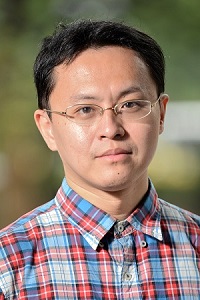- Speaker
- A/Prof. Hang-Hui Chen
- NYU Shanghai
- Abstract
New phenomena emerge in complex oxide thin films or heterostructures. In this talk, I will discuss two such examples. 1) Soft ferromagnets are relatively rare, particularly in ultrathin films with thicknesses of a few nanometers or less. However, ultrathin freestanding LaMnO3 films exhibit unexpected soft ferromagnetism along both the in-plane and out-of-plane directions when the film thickness was reduced to 4 nm. We argue that the vanishing magnetic anisotropy between the two directions is a consequence of two coexisting magnetic easy axes in different atomic layers of the LaMnO3 film. Our first-principles calculations show that protonation of LaMnO3 decreases the Mn valence and switches the magnetic easy axis from in-plane to out-of-plane as the Mn valence approaches 2+ from its 3+ bulk value. Our work demonstrates that ultrathin freestanding films can exhibit functional properties that are absent in homogeneous materials, concomitant with their convenient compatibility with Si-based devices[1]. 2) We provide design principles for inducing multiple topological states in (001) (AMO3)1 /(AM'O3)1 oxide superlattices. Aided by first-principles calculations and model analysis, we show that a (SrMO3)1 (SrM'O3)1 superlattice (M =Nb, Ta and M' = Rh, Ir) is a strong topological insulator with Z2 index (1;001). More remarkably, a (SrMoO3)1 /(SrIrO3)1 superlattice exhibits multiple coexisting topological insulator (TI) and topological Dirac semi-metal (TDS) states. The TDS state has a pair of type-II Dirac points near the Fermi level and symmetry-protected Dirac node lines. The surface TDS Dirac cone is sandwiched by two surface TI Dirac cones in the energy-momentum space. The non-trivial topological properties arise from the band inversion between d orbitals of two dissimilar transition metal atoms and a particular parity property of (001) superlattice geometry. Our work demonstrates how to induce non-trivial topological states in (001) perovskite oxide heterostructures by rational design [2].
[1] Q. Lu, Z. Liu, Q. Yang, H. Cao, P. Balakrishnan, Q. Wang, L. Cheng, Y. Lu, J. Zuo, H. Zhou, P. Quarterman, S. Muramoto, A. Grutter, H. Chen* and X. Zhai*, ACS Nano 16, 7580 (2022).
[2] Z. Liu, H. Liu, J. Ma, X. Wang, G. Li* and H. Chen*, npj Computational Materials 8, 208 (2022).
- About the Speaker
Dr. Hanghui Chen is an assistant professor of physics at NYU Shanghai and a global network assistant professor of physics at New York University. He obtained bachelor degree in Physics from Peking University and Ph.D. degree in Physics from Yale University. Before he joined the faculty of NYU Shanghai, Dr. Chen held a postdoc position in Department of Physics at Columbia University. Dr. Chen's research area is at the intersection of condensed matter physics and materials science. He uses state-of-the-art first principles calculations to study electronic, magnetic, structural and topological properties of quantum materials, with a particular emphasis on complex oxides and oxide heterostructures.
- Date&Time
- 2023-06-07 10:00 AM
- Location
- Room: A403 Meeting Room




